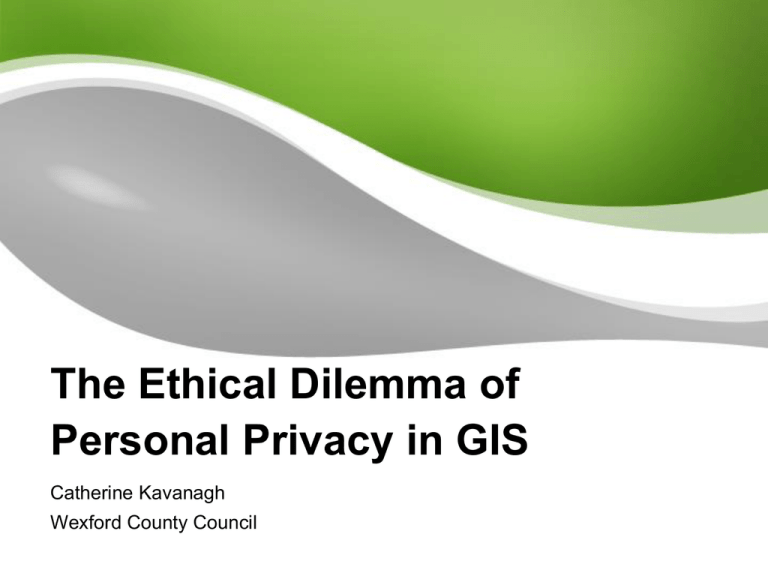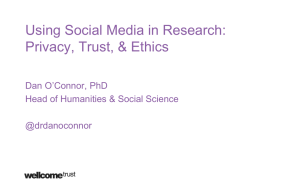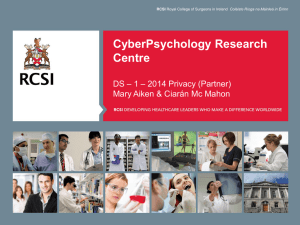The ethical dilemma of personal privacy in GIS, Catherine
advertisement

The Ethical Dilemma of Personal Privacy in GIS Catherine Kavanagh Wexford County Council Personal Privacy in GIS Who has information about us? Internet Usage and Technology Changes Increase in GIS & Effects on Privacy Data Integration & Geocoding Organisational Responsibility & Data Protection Legislation Page 2 Who has information about us? Page 3 Mapping our Location How many times are is our location and activity captured during the day – Receiving or making phone call – Sending or receiving texts – CCTV / tolls / travel cards on the way to work – Id card to access the office – Flextime system to clock in/out – Online access during the day – Using an ATM / laser card / store card Page 4 Questions What information is being stored? What use is being made of the information? Does it erode our privacy? Can we do anything about it? Do we want to do anything about it? Page 5 Personal Privacy & Ethics The development of computerised information systems means that privacy is now a matter of the protection of data about oneself (Curry, M, 1999). Ethics implies civic responsibility on the part of citizens and responsibility by society’s institutions, including governments. Page 6 Internet Users in Ireland 3,500,000 3,000,000 2,500,000 2,000,000 1,500,000 1,000,000 500,000 0 2000 Page 7 2002 2008 2010 Source – InternetWorldstats.com PC Ownership & Broadband Access 58% 21% 2006 Households with PC Page 8 74% 65% 2011 Broadband Access Source – www.census.ie Disclosure of Personal Data Social Network Site Online Shopping Aware of data collection conditions Control of Personal Data Page 9 Attitudes on Data Protection and Electronic identity in the European Union, June 2011 Changes in Technology Home Work Affordable computers Cost of computing capability Accessible broadband Cheap / OpenSource software Social Networking Online & Free Training Web apps / Mobile apps Web apps / Mobile apps Location Based services Location Based services Smartphones Cloud computing Telematics Page 10 Increase in use of GIS Mobile devices - phones, laptops, ebook readers, digital cameras, and gaming devices -- are location aware Availability of online mapping sites / Streetview / orthophotography Location Based Services Positioning Systems - GPS & IPS Online data capture / Increased availability of data Low cost of GIS integration / cost of GIS software Page 11 GIS & Google Google maps released in 2005 1.1 million websites use Google API to integrate GIS functionality into their website 40% of Google map usage from mobile phone 200 million users in 2011 Page 12 Sources www.trends.builtwith.com Location Privacy & Telematics Location privacy – concerns the claim of individuals to determine for themselves when, how, and to what extent location information about them is communicated to others (Duckham, M. et al, 2006) Vehicular Telematics – Fleet management, car navigation, car theft tracking, vehicle diagnostics, speed monitoring Personal Telematics – Protection & safety benefits Page 13 Smart Phone Usage Smart phone ownership at 43% in Ireland in 2012 41% of smart phone users access mapping or travel apps Information that smartphones collect • What services you use and how you use them • What search queries you used • IP address, browser type, language, date and time of your request, unique cookie id to identify your computer • Telephony log information such as phone number, number called, time and date of call, duration • Location Page 14 Source Amarach Research Example - Geotagging Page 15 Geotagging Page 16 GIS & Data Integration Geographic information is factual information about land and resources – when matched with other data about individuals may become personal information – GIS is a powerful data integrating technology – Adds value to the data – Makes data more relevant for analysis and decision making Page 17 Census Information – Small Areas Page 18 Source – www.maps.pobal.ie Limitations of Data Integration Capacity for integration of spatial information and personal information from multiple sources Limitations of geocoding in Ireland – 35% approx of all address are non-unique – Varying address structures – Different spellings – Two languages – Errors in data entry Page 19 Geocoding – Benefits & Difficulties Benefits – Centralised address database – Single view of the customer – Improve data management – Improve efficiencies Difficulties – Non-unique address – 39% in Wexford – Maintain Data Privacy Page 20 Local Authority Datasets Department Dataset Planning Applications, Enforcements, Preplanning, Protected Structures, Dangerous Structures Housing Environment Rents, Grants, Loans, Applications, Housing Stock …. Water Network, Sewerage Network, Connections, Commercial Meters, Domestic Meters Licencing, Enforcement, Complaints Register Register of Electors Rates Commercial customers Roads Road Network, Water Page 21 Example 1 - Planning Legislative requirement to digitise applications and make this data available to the public Applications back to 1985 are available Viewable online Valued source of information to public and staff Inherent right of public to access this information Digitise applications, enforcements, preplanning, dangerous structures Page 22 Example 1 - Planning Page 23 Example 2 - Septic Tank Registrations Page 24 Example 3 - Rates 5,000 rateable properties 6 months to digitise Difficulty with database & rural addressing Used local knowledge 80% success rate Compare with geodirectory Find businesses not assessed for rates Maintain privacy - Benefit to customer Page 25 Example 3 - Rates Page 26 Example 3 - Rates Page 27 Example 3 - Rates Page 28 Postcodes – A privacy issue? Save duplication Improve efficiency Opportunities Remove urban v rural divide Must have unique postcodes Overhead of implementing postcodes must have benefits Integrated with geodirectory Page 29 Organisational Responsibility Organisations have a responsibility to be aware of their legal obligations regarding data privacy and protection Data Inventory – Know where the data is and who has access to it – Identify and prioritise Protection of personal data – People – Process – Technology Page 30 People & Process – All staff • Application of Data Protection legislation • Awareness of organisational privacy policy – GIS Staff • Implications of geocoding and data matching • Data integration must not impinge on personal privacy – Process of data • Available to only those entitled to view it Page 31 Technology Proactive approach Risk Assessment – Technology changes i.e. cloud computing etc – Access policy Implement data security – Firewalls, Password protection, Antivirus protection & Encryption policies – Awareness of non-intentional disclosure and access Page 32 Data Protection Data Protection Acts of 1988 and 2003 provide protection of the right of individuals to data protection Put responsibility on organisations to protect personal data Need to be modernised Disclosing personal data is a part of modern life Impossible to opt out Page 33 Data Protection New legislation proposed to provide – A ‘right to be forgotten’ – Explicit consent – Single set of data protection rules across the EU – Give individuals more control over their personal data – Standardised regulation to benefit business Page 34 Conclusion Organisational challenge – Act within legislative framework – Protect privacy – Exploit location data to improve services and efficiencies while maintaining the privacy of sensitive data Personal challenge – Awareness of new technologies – Protect personal data Page 35







